This week’s rate the dress illustrates how widespread the global textile trade was in the mid-19th century, and how a dress worn in Europe or the Americas might be made from fabric woven in China. It also brings up an interesting discussion of how Asian fashion and textiles have been perceived, and pigeonholed, in the West.
It’s a discussion that deserves a bit of time, which is why this post took me so long to write!
Last week: a draped evening dress of the early 1910s in lilac pink
Most of you loved, loved, loved the Jays Ltd evening dress (or at least loved everything about it except the sash), but the few who didn’t, really didn’t, pulling down the overall rating just a smidge…but not that much!
The Total: 9 out of 10
It’s down .2 from the week before, but still oh-so-good. I swear I’m not purposefully only picking things I think you’ll all love!
This week: a mid-19th century day dress of Chinese silk
This week’s dress is an 1850s day dress made in Britain from silk imported from China.
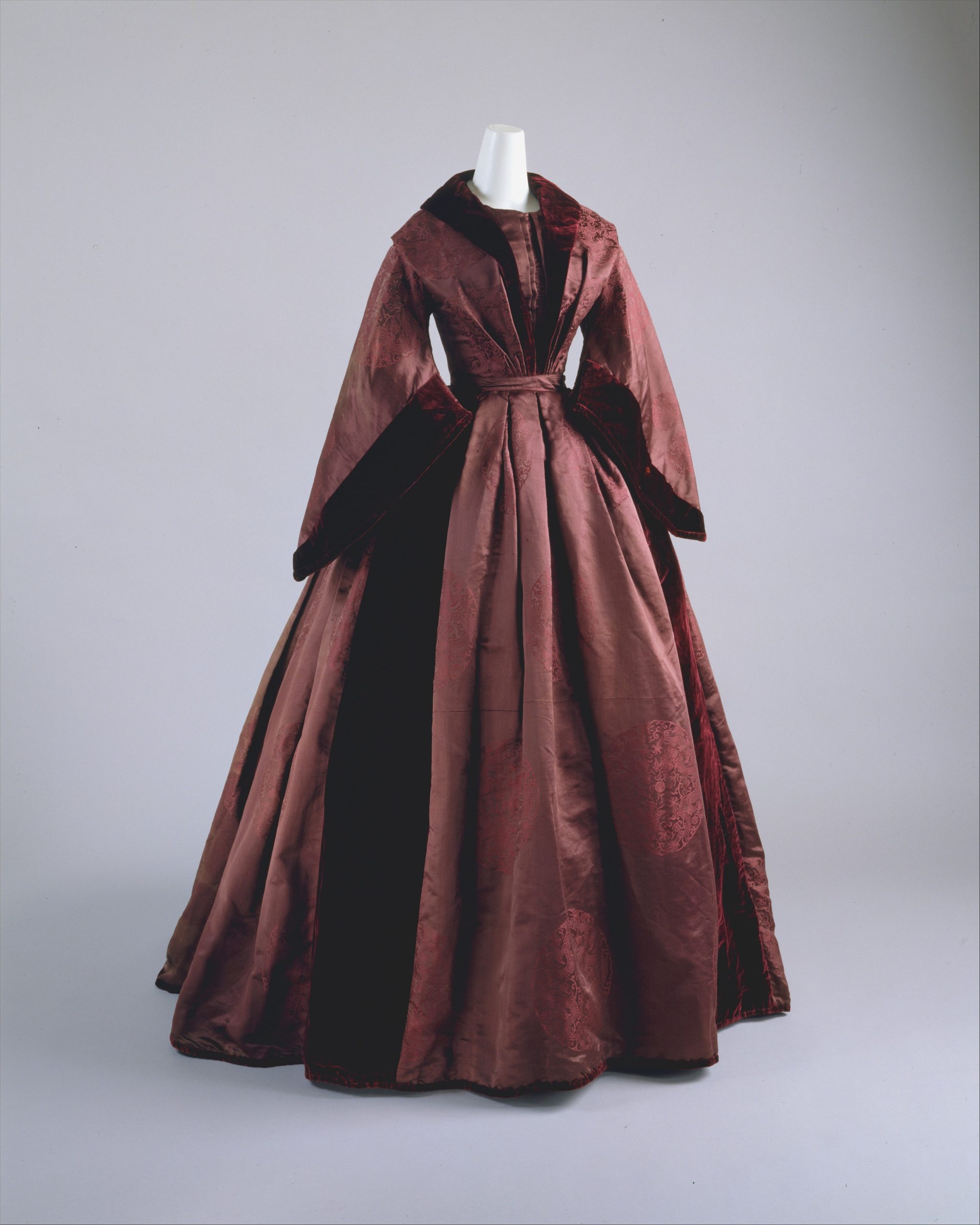
Day Dress, ca. 1850, British, silk, Purchase, Gifts in memory of Paul M. Ettesvold, and Judith and Gerson Leiber Fund, 1994, Metropolitan Museum of Art, 1994.302.1
The bodice of this dress is quite interesting. The velvet collar wrapping down the front is slightly reminiscent of dressing gowns of this period, giving it an almost informal feel that is at odds with the lush fabric and fitted waist of the dress
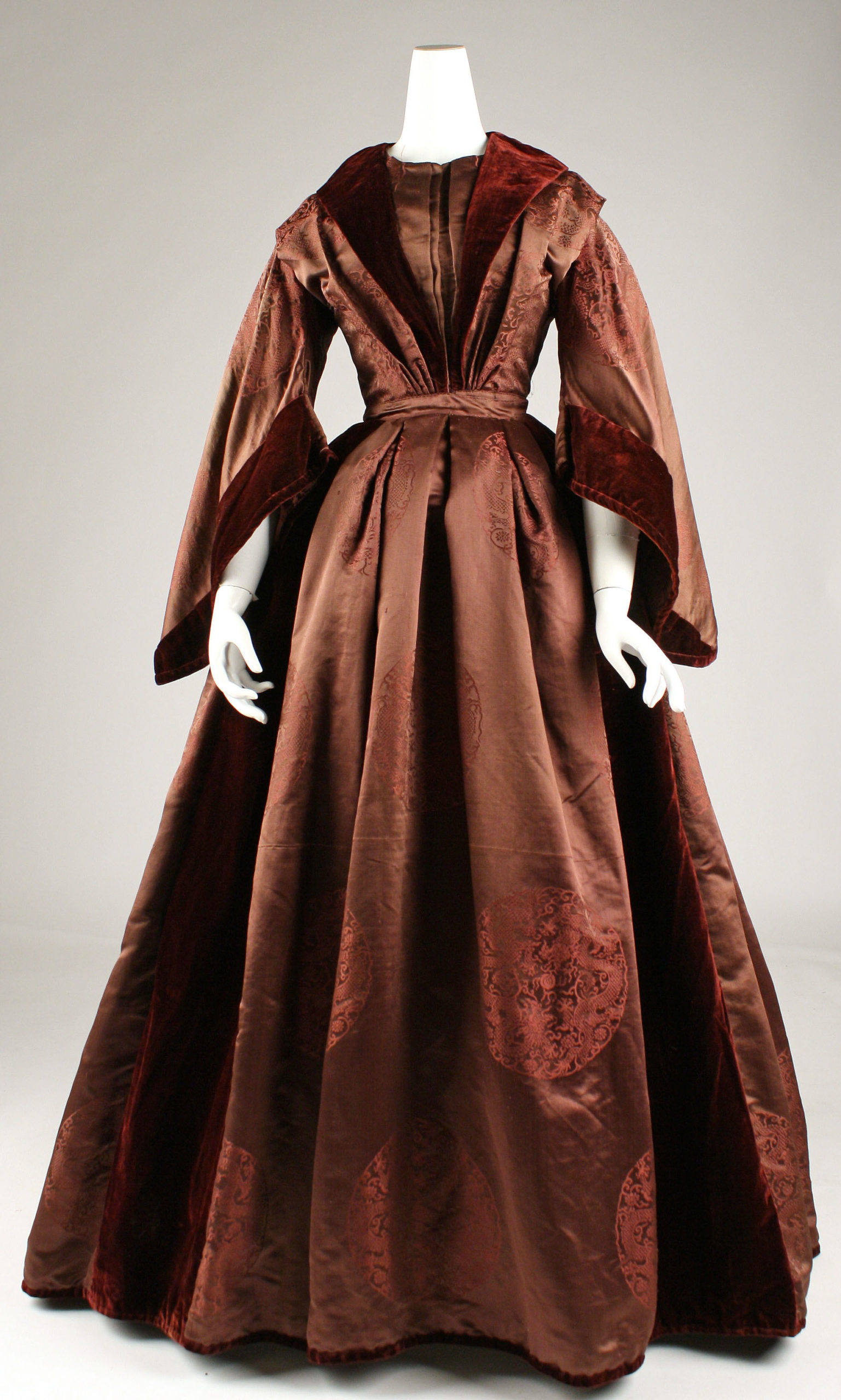
Day Dress, ca. 1850, British, silk, Purchase, Gifts in memory of Paul M. Ettesvold, and Judith and Gerson Leiber Fund, 1994, Metropolitan Museum of Art, 1994.302.1
The lush fabric is also quite interesting. Fabric has been imported from China into Europe for millennia, but few examples used in European clothing in the mid-19th century feature such obviously Chinese motifs.

Day Dress, ca. 1850, British, silk, Purchase, Gifts in memory of Paul M. Ettesvold, and Judith and Gerson Leiber Fund, 1994, Metropolitan Museum of Art, 1994.302.1
In addition to the brocaded dragon roundels on the silk, the fabric has manufacturers marks in Chinese on its selvedges. In the 1850s they were probably sewn into/embroidered on to the selvedges with thread after the fabric was woven, a technique still seen on some high end Chinese and Japanese silks.
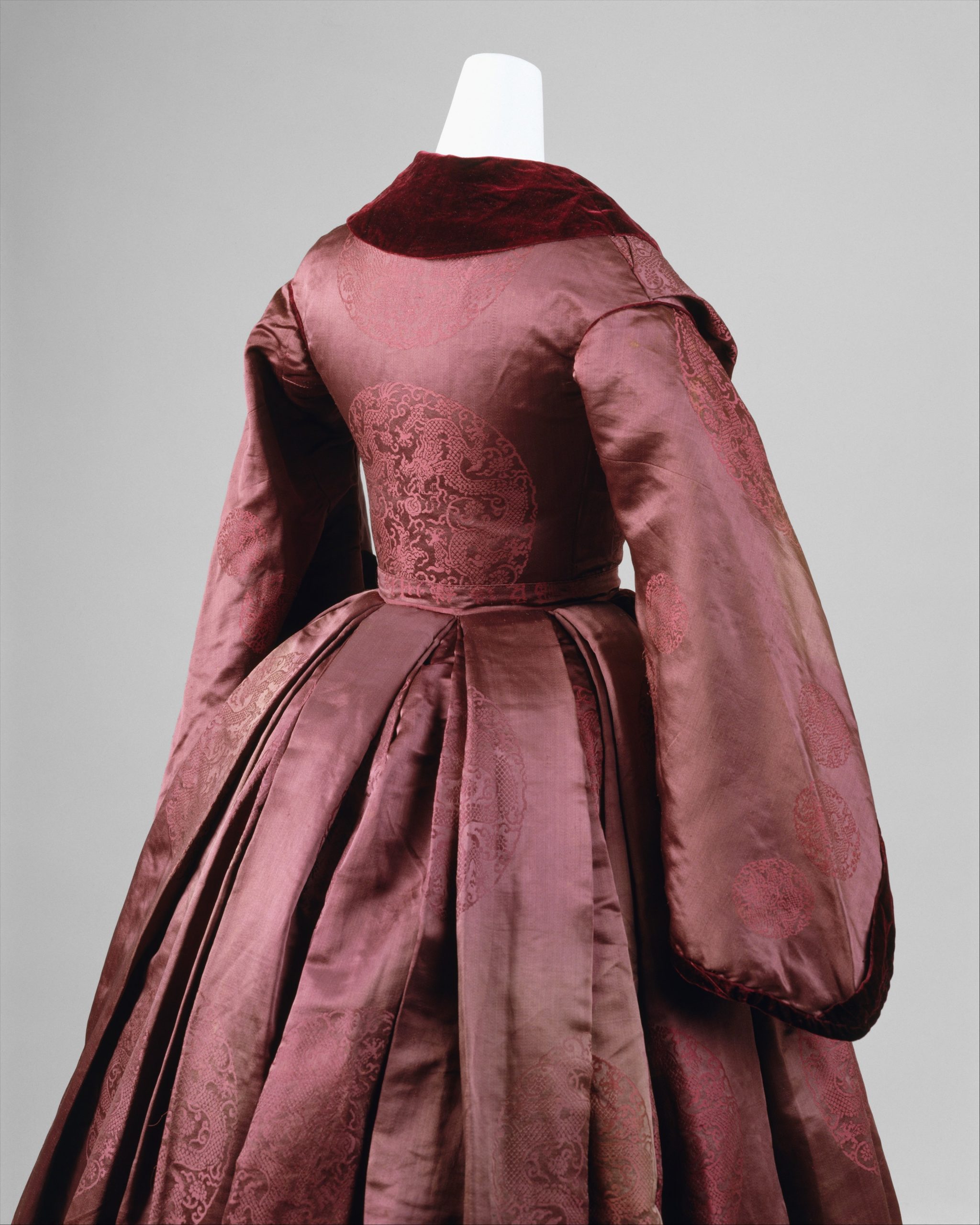
Day Dress, ca. 1850, British, silk, Purchase, Gifts in memory of Paul M. Ettesvold, and Judith and Gerson Leiber Fund, 1994, Metropolitan Museum of Art, 1994.302.1
Although there are many examples of formal garments made from textiles imported from China, India and Japan in the 19th century, there is also a strong link between patterns and designs that had their origins in these countries (and other areas of the world seen as ‘exotic’ to Victorians) and informal, private, intimate, garments. Think of all the examples of Victorian petticoats and corset covers decorated with paisley embroidery. Or tea gowns based on kimono? Dressing robes, banyans, and smoking jackets all had their genesis in banyans imported from India, jackets imported from the Ottoman Empire, and robes imported from China.
In the Victorian imagination, the ‘East’ was often a world of seraglio, concubines, opium dens, and harems. This image was perpetuated by accounts like Leonowen’s The English Governess at the Siamese Court (1870). Although 20 years later than this dress, it similar themes were covered in numerous other novels and bibliographies that influenced her work.
This image contributed to a tendency to use obviously ‘Oriental’ textiles for private garments which still has an impact on fashion today. It’s not a coincidence that the only lingerie store on Wellington’s priciest shopping street has been decorated with an ‘Asian exotic’ ‘geisha’ theme (their words) for the past 12 years (it’s a choice that I was gobsmacked by in 2009, and cannot believe is still in place in 2021).
The longstanding Western practice of pigeonholing Asian fashion as informal (and thus less worthy of being taken seriously) and inherently sensual has a wider social impact as well. For one, it contributes to negative stereotypes where Asian woman are both sexualised, and infantilised.
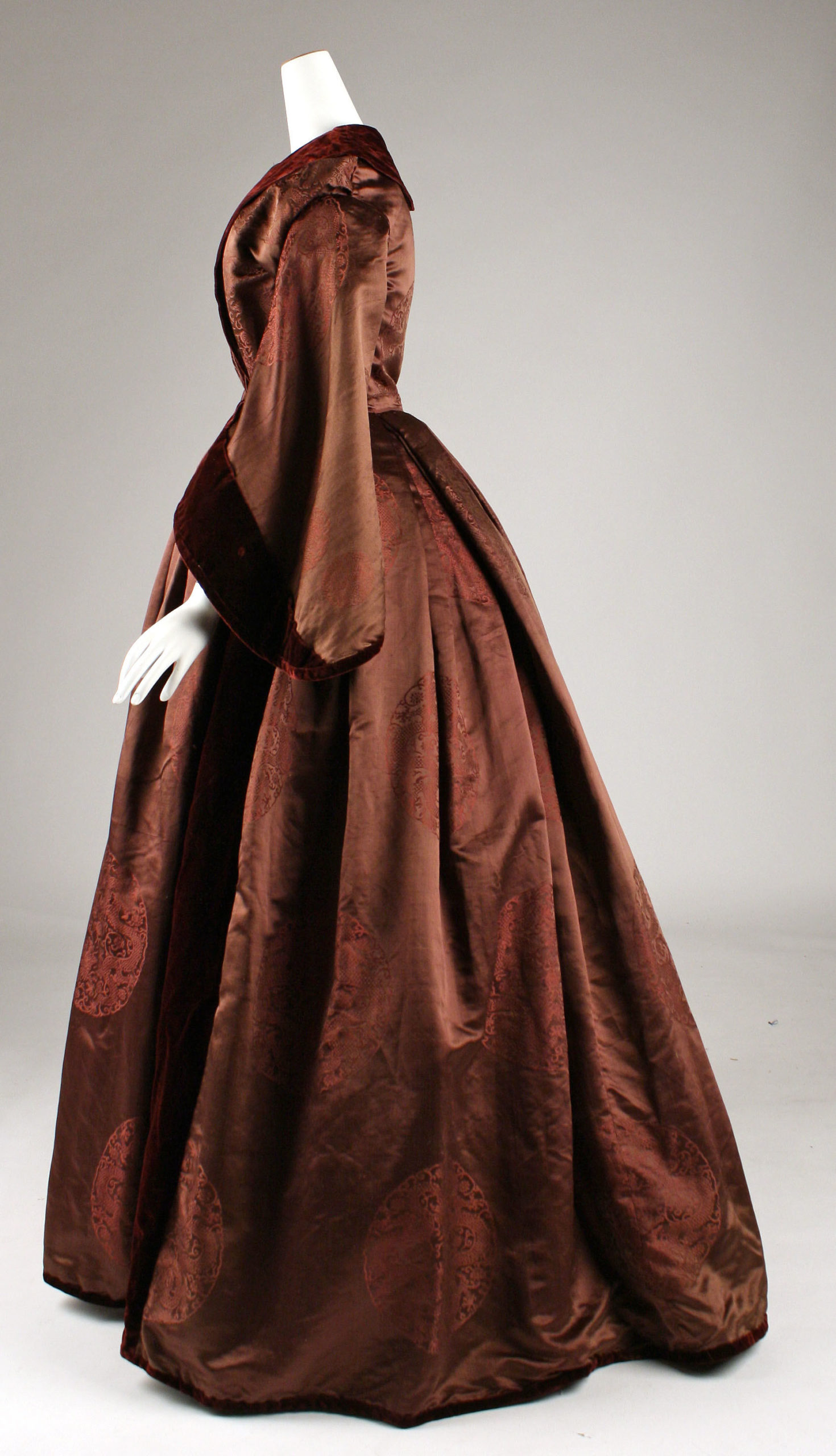
Day Dress, ca. 1850, British, silk, Purchase, Gifts in memory of Paul M. Ettesvold, and Judith and Gerson Leiber Fund, 1994, Metropolitan Museum of Art, 1994.302.1All of this makes this dress particularly intriguing. The combination of a textile with a very obviously Chinese design on a dress with a bodice that reads, at least to the modern eye, as more informal, brings up a number of questions.
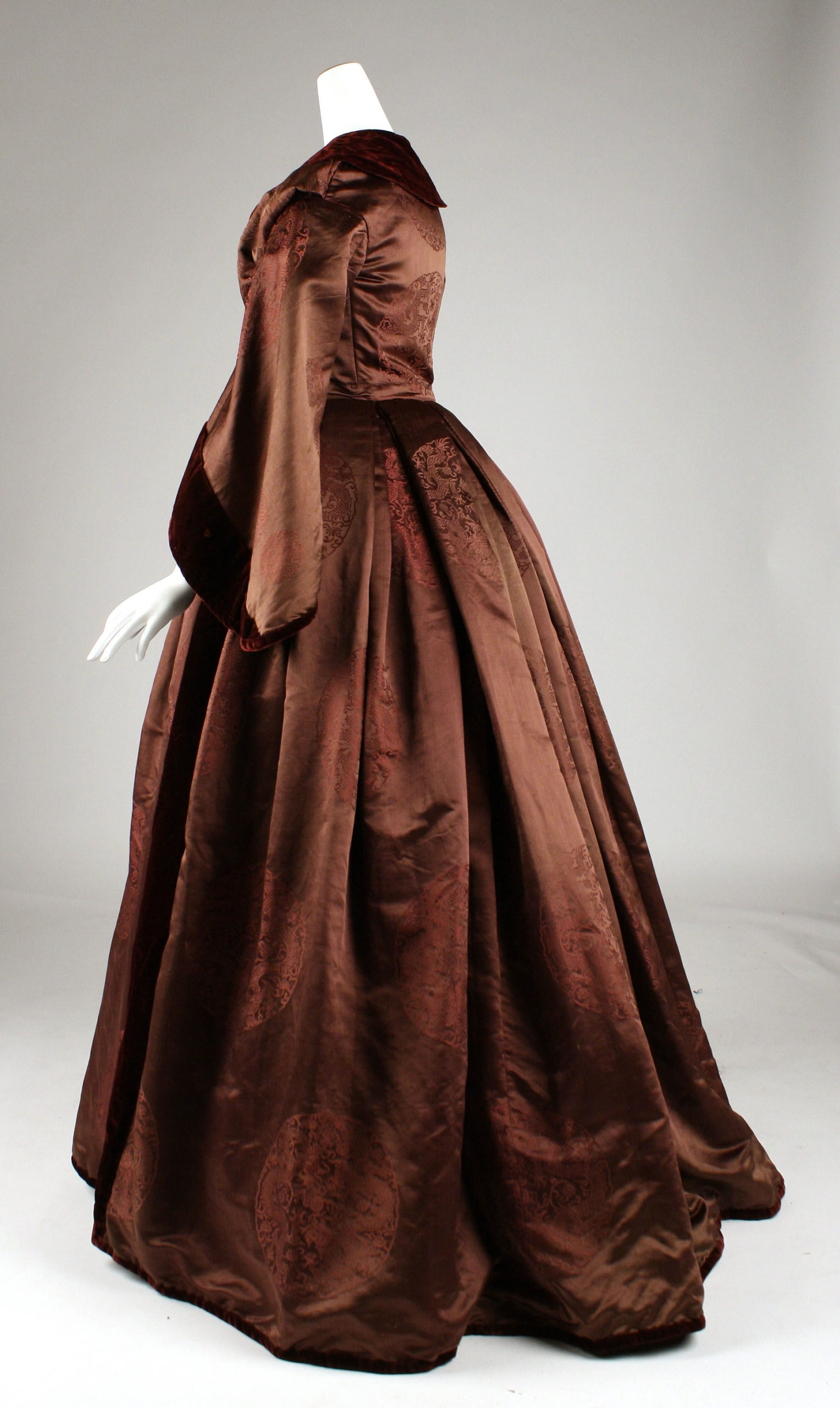
Day Dress, ca. 1850, British, silk, Purchase, Gifts in memory of Paul M. Ettesvold, and Judith and Gerson Leiber Fund, 1994, Metropolitan Museum of Art, 1994.302.1
Is this, despite the decadent textiles, an informal dress? Perhaps a morning dress, just a smidge up from a wrapper? Or are modern impressions colouring our view?
It’s true that the styling in the pictures that read as more brown are not helping the formality: the too-small hoop and too-low mannequin allow the skirt to trail on the floor.
It also pays to remember the dress would have been worn with engageantes (under sleeves, usually in white with lace and embroidery) and a white lace collar, both of which would make it read as more complete.
What do you think of the dress, aesthetically, and otherwise?
Rate the Dress on a Scale of 1 to 10
A reminder about rating — feel free to be critical if you don’t like a thing, but make sure that your comments aren’t actually insulting to those who do like a garment. Phrase criticism as your opinion, rather than a flat fact. Our different tastes are what make Rate the Dress so interesting. It’s no fun when a comment implies that anyone who doesn’t agree with it, or who would wear a garment, is totally lacking in taste.
As usual, nothing more complicated than a .5. I also hugely appreciate it if you only do one rating, and set it on a line at the very end of your comment.

Oh I *love* this dress, and the 1850s isn’t even my preferred decade of that century! Imagining it with a spill of white lace at the neck and wrists, shimmering in candlelight… Perfection. I would wear this in a heartbeat!
10
overall, i really like the dress. i think it’s pretty, and very wearable, with a sort of understated elegance that both comes from and showcases the fabric used to make it. i am having some difficulty pinning it down to a specific level of formality; in many ways, it seems like it straddles the line between morning and afternoon dress? my gut feeling leans toward afternoon gown; i think it was meant to be seen outside the strictly intimate or domestic confines of its owner’s life, perhaps in receiving callers at home, and other “half dress” occasions.
i looked twice at the date; this dress, to me, has almost a look of the aesthetic movement. i double checked the date of that movement, and in doing so noticed that the ‘great exposition’ in london was in 1851, one year after the date on this dress…that exposition was a sort of carnival of the exotic goods of empire and the wonders of the industrial age spooling up, so a gown featuring ‘exotic’ fabric would have been on trend, perhaps.
chinese silk brocades were prized by many nations over a long period of time, and were incorporated in status garments by many cultures, including within china itself. and we humans have always been prone to admire (and trade) what is different and unusual to us. but there is no question that european nations with imperial aspirations made a particularly brash, self-congratulatory use of all things ‘exotic’…there is a sick-making sense of their regarding all the world as a buffet from which they were entitled to choose what enriched or titillated them that is most repugnant today.
as someone who studied asian cultures, especially japanese culture/art, as part of my degree program, i am familiar with the western misapprehensions about geisha subculture and the myth of the compliant asian woman (which ultimately says very little about asian women, and a great deal about western men)…it’s a view which marketing and consumers have not yet given up entirely, as sadly illustrated by your wellington lingerie retailer. sigh. textiles certainly can serve as a remarkable encapsulation of global links, the good, the bad, and the ugly. following cathy hay’s research and recreation of the “peacock dress” project is an object lesson in that!
it is to me still a beautiful, very wearable, dress. and for its time, rather a sophisticated (in the best sense) use of the fabric, perhaps.
rating: 10/10
I find the fabric exquisite, rich yet subtle, and the lines of the dress graceful. The fabric seems to be substantial enough to stand up to the weight of the velvet trim.
10 of 10
The dress is a beautiful color and the cut and drape of the material is very appealing, I also love the velvet detailing. That being said the weight of the material looks abnormally heavy and makes the gown look almost… bathrobe-ish? I would probably wear it but only at home on a very cold day.
7.5/10
The rich color is amazing. I love the design on the fabric and the coordinating velvet trim. It does look a little bit heavy but I think to me that adds to the luxuriousness of it. If I could give it higher than a 10 I would so 10 out of 10 for me this week.
Such a beautiful dress. The only fault I see is that the sleeves are hanging oddly on the dress form; I’m going to assume a living person would naturally move them in a more anatomical position in wearing them and eliminate the sag.
The color is amazing, as is the contrast between the silk and velvet. And those pleats! I really love this dress overall. This is one of those things that makes you happy because it exists.
10/10
Lush and beautiful, verging on majestic. I don’t know how it would have been “read” in its own years, but it does not seem informal or “bathrobe-like” to me. Don’t many 1850s dresses have bodice shape that makes a V shape from the shoulders to the waist? Were collars and engageantes always frothy or frilly or were they ever fashioned in more subtle or restrained designs? I hope so! “Frill” doesn’t seem like it would complement this restrained elegance.
Oh, nearly forgot: 10.
Many 1850s dresses do have the V shape, but it’s very firmly sewn down as part of the dress. The effect of one layer over another that gives the impression a V neck robe with a velvet collar over a fitted underbodice, is quite unusual.
I wonder if the front V folds are meant to evoke the crossed fronts of layered robes, adding to that “Asian” impression.
It’s a fabulous textile and a fascinating dress, though I agree maybe not the best-presented in these photos. I wonder if the medallion design is more evident in real life–since it only shows up in the closeup photos it almost seems like a “secret.”
9/10
Just fabulous. 10 of 10. Love how the woven medallions are showcased on the back of the bodice.
This is a breathtakingly beautiful dress. Definitely a 10/10 from me!
I think it’s stunning, and if I could give an 11 I would. 10 out of 10.
I see it as more late medieval than informal. All we need is the hennin with the floaty bit, and we are there, albeit in the horizontally fuller 19th C. style. The sleeves are perfect, too. And that fabric! Love it – rich, rich colour and fascinating motifs.
I can definitely see it as quite Burgundian, with those sleeves and that bodice!
I am also getting medieval houppelande vibes. Lots of elegant draping in rich fabrics.
But I can also see the dressing robe elements, especially with the layered open pleating at the front. But I wonder if that is meant to evoke more traditional Chinese layered styles.
The velvet is sumptuous, and probably adds to that feeling of sensuality (similar to the draping and velvet of the 1895 dress a few weeks ago). But that effect might be reduced with proper under-pinnings and accessories.
It does look stunning though. It certainly seems unusual for its time too. 8/10 for me.
Burgundy! That was my immediate reaction, before even noticing the Chinese emblems brocaded into the silk. The lines. The fur. The weightiness. Gorgeous.
10 of 10
9/10. The contrast of textures is visually rich but not overwhelming, though I wish the dress was better displayed.
The manufacturer’s inscription at the back waist is woven, and while incomplete, reads:
æå·žç»‡é€ è‡£ç¦*(there is one more character to the left of ç¦ but I cannot make it out)
The inscription, translated, reads:
“The Hangzhou Imperial Weaving Workshop, Your Servant Fu…”.
The dress was not made from export silk, but the best quality stuff, reserved for the use and gifting of the Qing imperial family. The five-toed dragon was a symbol of imperial rank, and would not have been sported willy-nilly on clothing in pre-1912 CE China.
Judging by the appearance of small roundels on what seems like both sleeves, I think the damask used may have been woven à la disposition for Chinese garment or garments, or for interior decoration.
IMO, it’s more likely that someone was gifted the fabric by a high-ranking Chinese aristocrat, and they (or someone else who got the fabric) had the fabric made up into a dress. There are, of course, also the Opium Wars to consider.
*This is in Simplified rather than Traditional script, but the difference does not change to the meaning of the inscription.
An addition to my previous commentary:
I did a bit of digging about who Fu-something could be. Of all the Imperial Textile Commissioners of Hangzhou, there is only ç¦æµ·/Fu Hai, who held the position from 1775-1783 CE (Year 40-48, Qianlong Era).
Not only was this c. 1850s CE dress made from imperial textiles, it was made from relatively old imperial textiles, too.
Thank you for looking into the fabric itself more! The fact that you could find that information at all is amazing! What detailed records the imperial court had!
Well, bilingualism/multilingualism is a pathway to many abilities some consider to be unnatural…
I jest- but it is a most useful skill to have. It opens up whole new worlds of things for me.
The inscription at the back waist is actually upside down as it stands. I had to rotate the image of the dress 180 degrees to read it. Then it was a matter of looking up which of the Hangzhou Imperial Textile Commissioners had that particular character in their name. However, the article I found Fu Hai in could well be inaccurate.
Fascinating !
10/10 for the dress
Thank you so much for this contribution!
I don’t love brown but I love this dress!
9/10
Putting aside all the questionable appropriation and just regarding the dress as it is, all i can say: stunning! breathtaking, i would wear it immediately and feel regal! so 10/10
t’s a frigid morning and that dress looks like cozy perfection. I love the draping and the richness of the fabric. I’ve never thought about the association between Asian fashion and intimate or informal Western clothes — thank you for discussing that!
Based purely on aesthetics and not problematic associations: 10/10.
Where some see informality I see an exceptionally regal garment, from the colour to the dragon motif (which I think even Europeans connected with high status). At the 1850 dating it’s too early for it to be Aesthetic dress but I think it points in that direction.
10/10
The fabric is gorgeous. But the bathrobe vibe is much too strong for me, and I don’t like the sleeves at all. They might look better with the correct accessories, or draping and moving on a real person. But I still wouldn’t like it overall. 5/10
I just love this dress. It does remind my modern mind rather too much of a dressing gown but when I push that association aside I really enjoy it.
9/10
10/10
Love it there’s something rich and almost medieval about the top. Love the color and the material.
I like this dress a lot. The colors and fabrics are beautiful. I actually prefer it without the undersleeves and collar though I suppose that’s not how it would have been worn. Even the brownish pics look quite nice, my monitor makes it look more burgundy which I like.
I don’t love the collar thing in the front so much. I’m undecided on the velvet stripes in the skirt.
The history lesson was also interesting and appreciated.
8/10
A very lovely dress from the front. I’m not sure about the huge “target” on the back, although it is well centered. The velvet trim adds a nice touch.
The combination of a somewhat informal bodice, and a lush fabric possibly seen as “exotic” leads me to wonder if this might have a hint of the “demimonde” about it.
Rating: Nice, but not quite perfect 9.5/10
I’ve loved this one for years. Had no idea about the background (so thanks for sharing), just loved the aesthetic, with the shawl collar (I’m a sucker for shawl collars and own none, alas – I should probably do something about that). Probably actually helped by the fact it’s a less usual mid-19th century one because my preferences usually lean towards the earlier, 1840s end of that stylistic spectrum. 100% Would Wear in a not-brown burgundy.
10/10!
P.S. Also, upon further introspection, I realise my perception of it is probably coloured by the Central-to-Eastern European flavour to the fashion of the time that I got myself immersed in. Specifically, the “national costume” experiments of the time, many elements of which did draw on historical garments and garments from further East, although not that far East. Because I’m used to their experimental loose caftany coats and stuff, this actually unconsciously does not read as quite so exotic to me as it might otherwise. 😀
I think of Rate the Dress as as much of a reflection of current fashions as historical ones. Our comments show our own perceptions (you can often gage people’s generations quite accurately based on their reaction to certain elements – e.g. to some age groups lace is romantic, where it’s table-cloth-y to others), so of course there’s a geographic/cultural reflection to how we see a garment. Even the way extant garments are staged and displayed is based on a particular time and taste in museum displays.
Oh yes, it’s definitely often more a reflection of us than it is of the dresses! I actually quite enjoy how much I have learned about myself – and learned, period – through Rate the Dress over the years. 😀
But now that I’ve had this revelation regarding this dress I badly want a red version with white velvet trim, along the lines of some of the “national costume” designs I’ve seen. 😀 (Those are usually just jackets, though.) I have no idea what I’d do with it but I want it! 😀
I like it a lot. I suppose that if it was a day dress, it was a day dress for a extremely rich lady, or the very best “recieving dress” to greet the important visitors in, still a very rich lady.
10/10
I love this dress. I love how intentionally the brocade rondels have been placed on the bodice. It reads as luxurious and cozy at the same time. I can imagine a wealthy woman welcoming friends to her home wearing this dress. I imagine a blustery, wintery day outside (not hard, that’s what the weather is doing here). Or I can imagine her reading, writing letters on her own. The overall effect of the dress is more medieval to me than informal. So my cozy is more to allay the effects of a draughty castle and not hanging out my bathrobe.
10/10